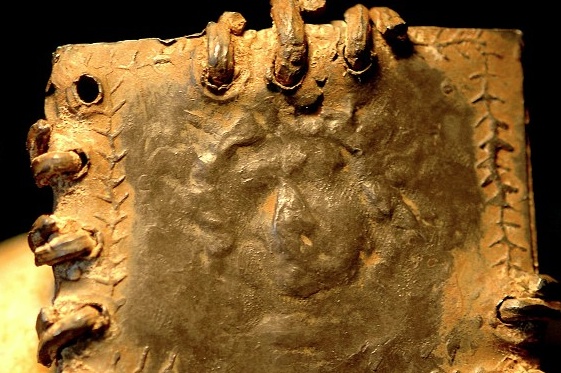
I was forwarded this interesting feature story by Museum of the Weird reader Chris Apgar, who works at citypages.com where this story was reported today. Here’s an excerpt from the first part of it, I recommend reading the complete story, it’s fascinating.
******************************************************************************************************************************************************************
CARVED INTO the hard stone of a hillside outside the Mexican city of Acapulco is a mysterious image that lay hidden for 4,000 years.
It shows a monkey with one foot lifted in dance. The monkey’s long tail curls over its head. The primate appears to be holding a five-pointed star. As in a scene out of Alice in Wonderland, the monkey is perched on the crown of a giant mushroom. Over one shoulder, a series of dots radiates like Morse code, and by the figure’s belly, more dots are arrayed around an assemblage of concentric rings. Off to the left is another constellation of three dots.
The Mexican archaeologists who uncovered this strange glyph say it was put there by the ancient Maya around 2000 BC. At that time, the grand cycle of existence laid out in the intricate Mayan calendar system was just 1,000 years old.
But the timing of the monkey’s rediscovery four millennia later is remarkable, because that long age is now drawing to a close. The year 2012 is widely thought to be the end of the Mayan calendar, which has been taken by some to signal the apocalypse.
Yet hidden in the simple lines of the mushroom monkey picture may be the key to a secret that upends everything we think we know about the Maya, their calendar, and the coming apocalypse.
Carl de Borhegyi, a Maya researcher in Minneapolis, has been studying the image closely, and says it has shocking implications.
“There’s all this excitement and panic right now about 2012 and the Mayan apocalypse,” de Borhegyi says. “But the message contained in this image turns all that upside down.
“Let me put it this way: What if the apocalypse already happened?”
THE WORLD is gripped by fear and fascination with what will take place on December 21, 2012. The significance of the date is traced back to the ancient Maya.
“There are roots in the actual Mayan calendars and texts, of course,” says Anthony Aveni, an anthropologist and astronomer at Colgate University who has studied the 2012 phenomenon. “But what we’ve seen is that as this phenomenon has taken root in popular culture, it’s served as a vehicle for a lot of New Age ideas and other pre-existing beliefs.”
The panic, which had until then mostly flourished on the internet and in specialty book shops, broke into the mainstream consciousness in 2009, when the blockbuster film 2012 brought visions of widespread devastation to a mass market.
“American religion has always been deeply rooted in apocalyptic endings, and we are coming off a decade of cataclysmic events, from 9/11 to the Japanese earthquake,” Aveni says. “I get emails from people telling me they’re going to commit suicide. They’re taking it seriously.”
That’s a mistake, says de Borhegyi, who believes the 2012 end date is based on a major miscalculation.
“The Mayans used a much different calendar from the European one,” de Borhegyi says. “There’s always been some debate about the correlation between the two.”
In the Mayan calandar, a tun is a unit of just less than 20 years. Twenty tuns are a k’atun, 20k’atuns are a b’ak’tun, and 13 b’ak’tuns make up a “great cycle.”
It is that great cycle—a 5,125-year period—that doomsayers and new-agers say is coming to a close on December 21, 2012.
But the cycle’s end depends on when it began, and not everyone agrees on where to start. By the time Europeans encountered the Mayans, they had stopped using the full “long count” calendar notation in favor of an abbreviation.
“It’s as though we started writing all our dates 2/25/11,” de Borhegyi explains. “That gives you some information, but if someone came along afterwards, they could get confused. Are we talking about 2011? 1811? 1511?”
The dominant theory for years has been the Goodman-Martinez-Thompson correlation, which pegs the start of the cycle at 3134 BC. That fits the known dates and some of the archaeological evidence, and also squares with carbon-dating evidence.
But so does another theory, called the Spinden correlation, which lines up 260 years earlier on the European calendar.
“That’s what makes this monkey so important,” de Borhegyi argues. “The dots over his shoulder represent a long-count date: 3.3.4.3.2. Under the Spinden correlation, that lines up with a year known as three-monkey.”
De Borhegyi points to the three dots on the left hand side of the carving. “Three,” he says, then points to the central figure. “Monkey.”
“If you use Goodman-Martinez-Thompson correlation, it doesn’t work,” he says. “All this talk about the end of the world-age, the apocalypse, Armageddon, planetary alignment—it’s wrong. It’s not happening in 2012. It happened [260] years ago.”
Read the rest: http://www.citypages.com/2011-04-06/news/revelation-2012/
And for the most detailed and accurate information, check out Carl de Borhegyi’s website mushroomstone.com.
******************************************************************************************************************************************************************
It makes sense if you think about the end of the last Mayan “great cycle” coinciding roughly with the birth of America in the late 1700’s. Perhaps the founding of the United States marked the beginning of the next great cycle that we are currently in? Any thoughts?







